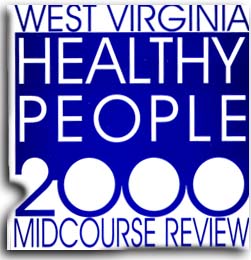 |
Unintentional Injuries |
 |
Unintentional Injuries |
Background
Unintentional injury continues to be the leading cause of premature death in both West Virginia and the United States. Moreover, injuries are the largest single cause of mortality among the young. Injury-related mortality in West Virginia exceeds the U.S. average for motor vehicle crashes, suicides, fire and burns, firearms, drownings, and traumatic brain injury.
Recognizing the degree of impact of unintentional injury on West Virginia's population, the West Virginia Bureau for Public Health (WVBPH) has established a program to begin the process of identifying community injury profiles and developing strategies to mitigate the various problems throughout the state. The Injury Prevention Program is housed in the Office of Community and Rural Health Services, Office of Emergency Medical Services.
The West Virginia Office of Emergency Medical Services (EMS) has been given the responsibility of developing a statewide injury control program within existing resources. Area and regional EMS offices will participate in the program to reach local community leaders with implementation strategies developed by the state office. These agencies will work together to address the problems of unintentional injury in the state.
The Objectives
OBJECTIVE 9.1 Reduce motor vehicle crash deaths for children aged 14 and under to 6.0 deaths per 100,000 population.
UPDATE Motor vehicle crashes are the leading cause of death among children aged 1-15, and the third leading cause of premature death overall. Since 1980, the mortality rate among children aged 14 and under due to motor vehicle accidents has ranged from a high of 10.2 deaths per 100,000 children (aged 14 and under) in 1990 to a low of 3.7 recorded in 1995 (see Figure 1). From 1992 through 1995, the rates have been markedly lower than the year 2000 target rate of 6.0 deaths per 100,000 children.
OBJECTIVE 9.2 Reduce the number of deaths from falls and fall-related injuries among persons aged 85+ to 105.0 per 100,000 population.
UPDATE The greatest incidence of deaths from falls occurs among elderly people aged 85 and older, and it is estimated that over $37 billion is spent annually in caring for such injuries. From 1980 through 1995, state mortality rates among persons aged 85+ due to falls have ranged from a high of 242.2 deaths from 100,000 population aged 85+ in 1980 to a low of 139.6 in 1987 (see Figure 2). At the present rate of decline, the projected rate for the year 2000 is 169.0, much higher than the target rate of 105.0.
OBJECTIVE 9.3 Reduce the mortality rate due to fire and burns among children under the age of 5 to 3.1 per 100,000 population.
UPDATE Fire and burn injuries and deaths are most frequently reported among children aged 0-4 and the elderly. Many of these deaths are the result of smoke inhalation, often due to the inability to respond quickly in an emergency. Since 1980, state mortality rates from fire and burns among children aged 0-4 have fluctuated from a high of 12.0 deaths per 100,000 children (aged 0-4) in 1993 to a low of 2.2 in 1983 (see Figure 3). Data for 1994 and 1995 show the age-specific rate for both years to be 2.8 deaths per 100,000, lower than the year 2000 target of 3.1. Maintaining this low rate is necessary to achieve Objective 9.3.
Meeting the Objectives
Health
Promotion Channels Worksites |
The Injury Prevention Program, West Virginia Office of Emergency Medical Services, has been designated as the lead entity in developing a statewide injury control program to address Objectives 9.1 through 9.3, as well as other unintentional injury problems. Using the six health promotion channels listed in the box to the left and discussed in detail in the Introduction, the area and regional EMS offices will provide direct citizen access and distribution mechanisms for public information and education. Other strategies include:
Unintentional Injuries - Meeting the Objectives
Lead Entity: |
Plan Coordinator: |